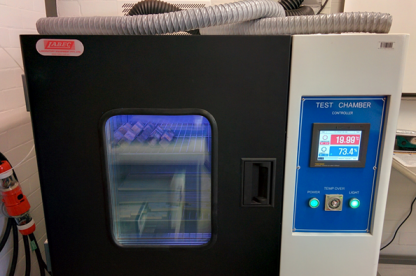Environmental chamber
The environmental chamber is a device that allows conditioning test samples to a specific temperature and relative humidity conditions.
Sample conditioning is important when evaluating the fire behaviour of materials whose properties may be affected by ambient conditions. Examples of these type materials include wood, concrete, and fabrics. Wood is a hygroscopic material, i.e. it has the ability to adsorb or desorbi water depending on the environment it is in. If wood is exposed to humid environments the amount of water stored in the sample increases resulting in a higher equilibrium moisture content (EMC). On the other hand, if wood is exposed to dry environments, it will release water resulting in a decreased in the EMC.
Temperature and relative humidity variations can result in changes to the EMC, thermal properties, etc., which in turn affect the solid heating and thermal decomposition. Controlling temperature and relative humidity allows researchers to 1) eliminate the influence of ambient conditions during fire testing and 2) parametrise environmental conditions to identify how the fire behaviour of materials changes in response to environmental conditions.
Our environmental chamber allows specification of temperature, relative humidity, or a combination of both. This device is intended for conditioning small scale samples in environments whose temperature ranges between 10-90oC, and relative humidity ranging from 10% to 90%.

